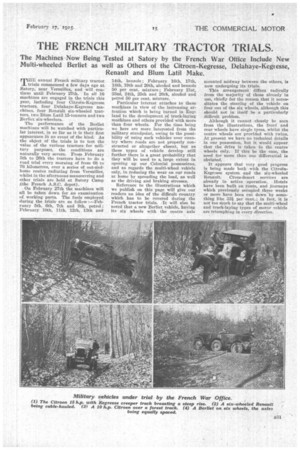THE FRENCH MILITARY TRACTOR TRIALS.
Page 15

If you've noticed an error in this article please click here to report it so we can fix it.
The Machines Now Being Tested at Satory by the French War Office Include New Multi-wheeled Berliet as well as Others of the Citroen-Kegresse, Delahaye-Kegresse, Renault and Blum Lath l Make.
mHE annual French military tractor.
trials commenced a few days ago at Satory, near Versailles, and will continue until February 27th. In all 16 machines are engaged in the trials this year, including four Citroen-Kegresse tractors, four Delahaye-Kegresse ma, chines, four Renahlt six-wheeled tractors, two Blum Latil 15-tonners and two Berliet six-wheelers.
The performance of the Berliet machines will be watched with particular interest, in so far as it is their first appearance in an event of the kind. As the object of the trials is to test the value of the various tractors for military purposes, the conditions are naturally very severe. From February 5th to 26th the tractors have to do a road trial every morning of from 68 to 76 kilometres, over a series of out-andhome routes radiating from Versailles, whilst in the afternoons manceuvring and other trials are held at Satory Camp (the French A.S.C. depot).
On February 27th the machines will all be taken down for an examination of working parts. The fuels employed during the trials are as follow :—February 5th, 6th, 7th and 9th, petrol; February 10th, 11th, 12th, 13th and 14th, benzole; February 16th, 17th, 18th, 19th and 20th, alcohol and benzole 50 per cent. mixture ; February 21st, 23nd, 24th, 25th and 26th, alcohol and petrol 50 per cent. mixture.
Particular interest attaches to these machines in view of the increasing attention which is being turned in England to the development of track-laying machines and others provided with more than four wheels. For the time being we here are more interested from the military standpoint, owing to the possibility of using such vehicles over country where roads are not properly con-, structed or altogether absent, but as these types of vehicle develop still further there is a great probability that they will be used to a„, large extent in opening up our Colonial possessions, and as regards the multi-wheel vehicle only, in reducing the wear on our roads at home by spreading the load, as well as the driving and braking stresses.
Reference to the illustrations which we publish on this page will give our readers an idea of the difficult country which has to be covered during the French tractor trials. It will also be noted that a new Berliet vehicle, having its six wheels with the centre axle mounted midway between the others, is now undergoing its trials.
This arrangement differs radically from the majority of those already in use, chiefly for the reason that it necessitates the steering of the vehicle on four out of the six wheels, although this should not in itself be a particularly difficult problem.
Although it cannot clearly be seen from the illustrations, the front and rear wheels have single tyres, whilst the centre wheels are provided with twins. At present we have no technical details in our possession, but it would appear that the drive is taken to the centre wheels only. If this be the-ease, the need for more than one differeutial is obviated.
It appears that very good progress is being made both with the CitroenKegresse system and the six-wheeled Renault. Cross-desert services are already in active operation. Hotels have been built en route, and journeys which previously occupied three weeks or more have been cut down by soMething like 33i• per cent.; in fact, it is not too much to say that the multi-wheel and track-laying types of motor vehicle are triumphing in every direction.
































